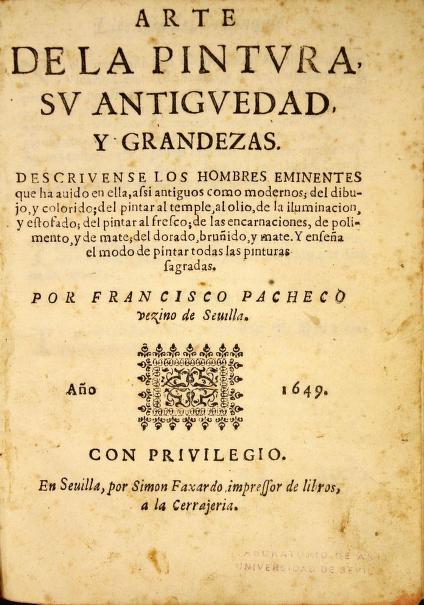
Frostispiece of Pacheco, El Arte de la pintura (1649), Seville, Simon Faxardo, impressor de libros, a la Cerrajeria
Depicting St. Philip as a eunuch is inadequate according to Pacheco study about the iconography of the saint. The author states that “there is no foundation for painting the holy Apostle as a eunuch, but as El Mudo [Juan Fernndez de Navarrete] painted him in El Escorial, following Raphael: as a venerable old man, eighty-seven years of age”.
“I notice that some painters, without any foundation, paint him as a eunuch, alluding, perchance, to the one who appeared to the servant of the Queen of Candaces and declared to him the place of Esaias and baptised him, who could not have been one either, as if this illness were attached to the name: […] and thus there is no foundation for painting the holy Apostle as a eunuch, but as the Mute painted him in El Escorial, following Raphael, in the sight of King Felix, with good agreement, in the view of King Felix. And so it is unfounded to paint the holy Apostle as a eunuch, but as he was painted, with good agreement, by El Mudo at El Escorial, following Raphael, in the sight of King Philip the Second and so many learned men: that he is a venerable old man, eighty-seven years of age, as some say”.
“Reparo en que algunos pintores, sin tener fundamento, lo pintan eunuco, aludiendo, por ventura, al que se apareció al criado de la Reina de Candaces y le declaró el lugar de Esaias y lo baptizó, que tampoco lo pudo ser, como si se pegara esta enfermedad con el nombre: […]y, así, no tiene fundamento el pintar eunuco al santo Apóstol, sino como lo pintó, con buen acuerdo, el Mudo en El Escorial, siguiendo a Rafael, a vista del Rey Felipo segundo y de tantos varones doctos: que es un anciano venerable, de edad de ochenta y siete años, como dicen algunos.”
Pacheco 1990, 674, n. 55;



